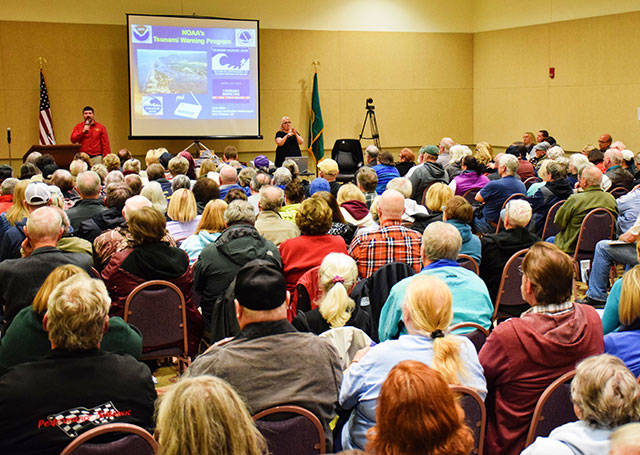The overflow crowd of at least 300 people at the Ocean Shores Convention Center last Wednesday for the second Tsunami Road Show presentation of the day in Grays Harbor was ample proof that the threat and probability of a tsunami along the Washington coast hits close to home.
Speakers for the state-sponsored program said they were genuinely surprised by the level of interest, and they offered several specific recommendations for how to survive a major earthquake and accompanying tsunami for people who live on the low-lying Ocean Shores peninsula, with its one roadway out of town to higher ground.
“There is no high ground in Ocean Shores. … You will not survive on the ground, you must get high,” said Charles Wallace, deputy director of Grays Harbor Emergency Management, urging people in Ocean Shores to seek shelter in second- or third-story homes of neighbors or anywhere above 20-30 feet.
Wallace encouraged the Ocean Shores crowd to look at long-term solutions: “What do we need to do for the future, and how can we survive, God forbid, if we ever have an event such as this? What critical facilities and buildings do we need to build so we can all get to them and have a shot?”
Maximillan Dixon, earthquake/tsunami program manager for the Washington State Emergency Management Division, noted tsunami waves don’t just come in as single waves, but rather “a range of waves, sometimes five or 10 or 20. So it’s really important for emergency managers, emergency responders and all of you in the public to understand that just because the first wave has arrived and inundated an area, doesn’t mean you are safe. … Stay away from it. There are more waves coming, and there may be larger waves coming.”
The danger can last 24 hours after a major earthquake and days for any maritime traffic, Dixon said.
As one of the main speakers, Dixon said the crowd size in Ocean Shores was impressive: “This is overwhelming in many ways. I love to see so many people interested in saving themselves.”
Wallace drew focused attention when he held up an All-hazard weather radio: “This is what will save your life. If you do not have one of these, especially, in Ocean Shores, you’re in a world of hurt.”
The radio allows users to receive all earthquake, tsunami and weather alerts for their specific area, county and state.
If a warning is issued, go to high ground immediately, Dixon said. That means at least a 3-foot wave or higher is coming.
For an advisory, waves of 1-3 feet are expected, but “they are still extremely powerful waves. Think of the full force of the ocean coming toward you. What this means is stay away from the beach, stay away from shore, stay away from the waterways, expect really strong currents.”
For a watch, like the one issue for the Jan. 23 earthquake in Alaska, people are advised to get ready for an advisory or warning. The other alert is known as an information statement, which can accompany a large earthquake when a tsunami is not expected.
Dixon also presented information designed to prepare people to survive should disaster occur: “You can survive the big one, you have a shot, you can do it. I believe in you.” Should a magnitude 7.9 to 10-point earthquake occur and the estimated tsunami wave be up to three hours away, Dixon said a warning automatically will be sounded through the radio, phone, and siren warning system.
“We want to make sure you get up, out and get to high ground as quickly as possible. That’s an automatic warning,” he said.
Watch the full presentation online: https://www.tvw.org/watch/?eventID=201804100watch/?eventID=2018041007



